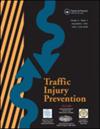Evaluation of lap belt-pelvis load transfer in frontal impact simulations using finite element occupant models
IF 1.6
3区 工程技术
Q3 PUBLIC, ENVIRONMENTAL & OCCUPATIONAL HEALTH
引用次数: 0
Abstract
Objective
The goal of this study was to examine the relationship between lap belt tension and force measured at the iliac wing and the effects of model type and torso posture on this relationship. From this analysis, preliminary transfer functions were developed to predict loads applied to the iliac wing as a function of lap belt tension at magnitudes typically measured in sled and vehicle crash tests.
Methods
A DOE study was conducted to provide a robust assessment of the lap belt-pelvis load relationship under various conditions. The GHBMC, THUMS, and THOR FE models were positioned in upright and reclined postures with several other intrinsic and extrinsic parameters varied for a total of 360 simulations. For the HBMs, instrumentation was developed to measure ASIS load at each iliac wing. Simulations that resulted in submarining were identified and removed from the subsequent development of lap belt-ASIS force transfer functions.
Results
The GHBMC exhibited submarining more frequently than the THUMS and THOR models. In addition to submarining, there were several cases in which the lap belt remained below the ASIS instrumentation or roped during the model’s forward excursion. These phenomena, particularly prevalent in the THUMS model, also influenced how the lap belt engaged the ASIS instrumentation and were thus eliminated from the transfer function development. Transfer functions relating peak lap belt tension and corresponding ASIS force magnitudes were developed for the GHBMC and THOR models in upright and reclined postures. In the upright posture, the THOR showed a higher level of ASIS load measured for a given level of lap belt tension than the GHBMC; however, in recline the lap belt-pelvis load relationship was similar between the two models.
Conclusions
The lap belt-pelvis load relationship was found to be affected by model type, posture, the area in which the ASIS instrumentation was defined, and occupant kinematics. This study showed it was possible to minimize the ASIS force by having the lap belt engage low on the pelvis and upper thighs, though further study is needed to determine if this loading mechanism is truly protective from an injury standpoint or an artifact of bypassing the ASIS instrumentation. The transfer function that showed the highest ASIS force measured for a given level of lap belt tension is recommended for future use.
使用有限元乘员模型评估正面撞击模拟中腹带与骨盆之间的载荷传递。
研究目的本研究的目的是检查腹带张力与髂骨翼测力之间的关系,以及模型类型和躯干姿势对这种关系的影响。通过分析,我们开发了初步的传递函数,用于预测施加在髂骨翼上的载荷与腹带张力之间的函数关系,这些载荷的大小通常在雪橇和车辆碰撞测试中测得:进行了一次 DOE 研究,以对各种条件下腹带与骨盆的负载关系进行可靠评估。将 GHBMC、THUMS 和 THOR FE 模型置于直立和后仰姿势,并改变其他几个内在和外在参数,总共进行了 360 次模拟。对于 HBM,开发了仪器来测量每个髂骨翼的 ASIS 负荷。在随后开发的腹带-ASIS 力传递函数中,对导致潜入的模拟进行了识别和剔除:结果:与 THUMS 和 THOR 模型相比,GHBMC 更经常出现潜入现象。除了潜入之外,还有几种情况是,在模型前倾过程中,腹带仍然低于 ASIS 仪表或被绳索缠绕。这些现象在 THUMS 模型中尤为普遍,它们也影响了腹带与 ASIS 仪表的接触方式,因此在开发传递函数时被排除在外。为 GHBMC 和 THOR 模型在直立和倾斜姿势下开发了腹带峰值张力和相应 ASIS 力大小的传递函数。在直立姿势下,THOR 在给定的腹带张力水平下测得的 ASIS 负荷水平高于 GHBMC;但在后仰姿势下,两种模型的腹带-骨盆负荷关系相似:结论:研究发现,腹带与骨盆负荷的关系受车型类型、姿势、ASIS器械的定义区域以及乘员运动学的影响。这项研究表明,通过让腹带在骨盆和大腿上部较低的位置啮合,可以最大限度地减小ASIS力,但还需要进一步研究,以确定这种加载机制从伤害角度来看是否真正具有保护作用,或者只是绕过ASIS器械的一个假象。建议今后使用在给定的腹带张力水平下测得最大 ASIS 力的传递函数。
本文章由计算机程序翻译,如有差异,请以英文原文为准。
求助全文
约1分钟内获得全文
求助全文
来源期刊

Traffic Injury Prevention
PUBLIC, ENVIRONMENTAL & OCCUPATIONAL HEALTH-
CiteScore
3.60
自引率
10.00%
发文量
137
审稿时长
3 months
期刊介绍:
The purpose of Traffic Injury Prevention is to bridge the disciplines of medicine, engineering, public health and traffic safety in order to foster the science of traffic injury prevention. The archival journal focuses on research, interventions and evaluations within the areas of traffic safety, crash causation, injury prevention and treatment.
General topics within the journal''s scope are driver behavior, road infrastructure, emerging crash avoidance technologies, crash and injury epidemiology, alcohol and drugs, impact injury biomechanics, vehicle crashworthiness, occupant restraints, pedestrian safety, evaluation of interventions, economic consequences and emergency and clinical care with specific application to traffic injury prevention. The journal includes full length papers, review articles, case studies, brief technical notes and commentaries.
 求助内容:
求助内容: 应助结果提醒方式:
应助结果提醒方式:


